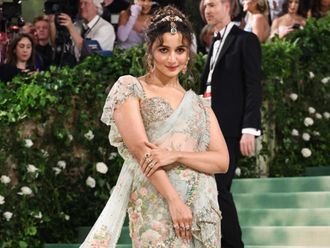Thirty years ago, before the East End of London was a hive of hipsterdom, home to an Ace Hotel and an Opening Ceremony outpost, the first Casely-Hayford studio sat there, roughly the size of a football field. It was the creative home of the designer Joe Casely-Hayford, whose family home was just down the road. “You couldn’t buy a cappuccino here,” said Casely-Hayford, speaking recently at what may pass for a tableau of Times Have Changed: the Ace Hotel’s thrumming lobby coffee bar. “You’d be shot if you asked for a cappuccino.”
“I remember prostitutes,” his son, Charlie Casely-Hayford, chimed in.
The East End has changed — the prostitutes, a neighbourhood feature since at least the days of Jack the Ripper, who stalked the area, have mostly cleared off. But the Casely-Hayfords remain, living and working nearby. They no longer share living quarters, but the younger, after an education in art and a brief career in fashion styling, has joined forces with the older, and for five years, they have collaborated on the men’s wear line that bears their name.
The label represents the meeting of generations and points of view. Joe Casely-Hayford, 58, brings the sartorial bona fides, having trained at the traditional Tailor and Cutter Academy, worked with the suitmaker Douglas Hayward and served as creative director of Savile Row’s Gieves & Hawkes. His 28-year-old son is a reliable barometer of the style of the day, a poster boy (literally, having been called upon to model for Converse, Dr Martens and W Magazine) for a certain brand of homegrown East End cool.
He comes by it honestly.
“Charlie’s born and grown up in the area,” said James Brown, the owner and founder of the local boutique Hostem, which has carried the collection since it opened in 2010. “He’s been very much a part of the creative community that’s done so much in East London. I think the collections are very much influenced by the area, the different communities that live in the area: the Bangladeshi culture, the punk culture.”
If Casely-Hayford reflects the neighbourhood, it also transcends it.
“We comfortably sit between English sartorial style and British anarchy,” is how Joe Casely-Hayford described their aesthetic, though the poles don’t split along generational lines: He brings as much anarchy as does his son. It was one of the foundations of Joe Casely-Hayford, the namesake line he started in 1984, and a quality that endeared him to bands like the Clash and U2, for whom he designed stage costumes.
Even at Gieves & Hawkes, a tailor famous for its handful of warrants of royal patronage, his most famous piece was a pair of wingtips whose broguing, rather than being meticulously applied, was blasted scattershot over the entire shoe, a result of taking a prototype pair to a shooting range and letting fire.
Throughout a long career, he has alternately embraced and rejected the reigning norms of the establishment, which has, in turn, celebrated and been wary of him. Traditional tailors, like those he trained with, were horrified of his “New Conservatism” pieces, like formal tailored jackets made from vintage World War II parachutes. But later, Princess Diana was a famous guest at a 1995 Joe Casely-Hayford show.
Working as a black designer in a largely white industry “definitely dictates my approach to design,” he said. “I designed from an outsider’s point of view. When I first started, there were no role models for me. I was very interested in creating a cult for the individual, for outsiders who wanted to make their own expression without shame.”
His son eventually found his way to the family trade, first as a sounding board for his father, then as a full collaborator. He called their process of developing Casely-Hayford into a full collection over the course of several seasons an exchange.
“It was quite weird that we were doing it in a public arena,” the younger Casely-Hayford said. “Each collection we put out was almost like a conversation between the two of us, finding our step. One season we’d go a little bit this way, one season we’d go a little bit that way. I think we finally reached the point where we thought this is where we want to be.”
Having arrived at that place, they took the collection to the runway for the first time in January, during London Collections: Men. Their fall collection, now arriving in stores, was based on a complicated stew of art-historical references (the de Stijl movement, the “anti-mass” sculptures of Cornelia Parker) but had a visceral charge owing largely to the mix of smartly tailored suits with muzzy flannels, wild prints with stark black and white. While not unheard-of (especially in London circles), the Casely-Hayford collection had been largely under the radar, selling mainly in Japan, where much of it is produced. After the show, the pair says, its number of stockists doubled.
Despite twice the retailers, Casely-Hayford’s reach is still relatively small, at least outside of its native London, where it has recently been picked up by Selfridges, and Japan. In the United States, it is sold at Dover Street Market, the first retailer to pick up its collection when the line began (then for its London and subsequently Tokyo outposts), and at a handful of boutiques and online. It is telling of its current centre of gravity that Barneys New York’s Japanese licensee stores carry it, but the Barneys New York American stores do not.
The front row of Casely-Hayford’s second show, however, at the subsequent London Collections: Men in June, suggested that, among musical cognoscenti, the line is gaining ground.
Unlike many other collections, for which “people are clearly paid off to sit there,” Charlie Casely-Hayford said, “it’s people that we’ve made suits for, or worked with over the years, that actually want to come down to the show.” (Before beginning the line, Charlie Casely-Hayford styled several musicians, including the xx.) They included the English musicians Florence Welch of Florence and the Machine (in a custom Casely-Hayford suit), Carl Barat (late of the Libertines and Dirty Pretty Things), Jessie Ware, Jack Penate, Tinie Tempah and Mr Hudson — pound for pound, perhaps the densest celebrity concentration of the week. Before that, James Blake, a Grammy nominee for Best New Artist, had turned up at the awards wearing a custom Casely-Hayford suit.
To address a growing demand for custom suiting, for clients as well as for celebrities, Casely-Hayford began offering made-to-measure service, conducting consultations and fittings in Hostem’s lower-level tailoring area. “Charlie does every single one,” said Brown, who estimates that Casely-Hayford is in the store to do so five or six times a week.
Whether the admiration of musicians and celebrities will translate to a wider audience remains to be seen. But the receptive audience they are finding augurs well. At the Ace, Charlie Casely-Hayford wore a striped sweatshirt from the fall collection he said he had designed with the rapper Drake in mind. Drake’s stylist had come to London, saw it, and soon after, Drake was wearing it around New York.
In any case, the connection they prefer to focus on is closer to home. “It was finding our sync between the two of us,” said Charlie Casely-Hayford, which felt like their biggest step forward.
It’s tempting to think it was fated from the start. “We share the same birthday,” his father added.
— New York Times News Service












